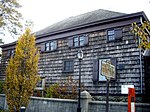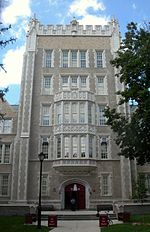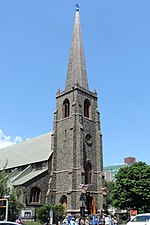Flushing Town Hall

Flushing Town Hall is a historic Town Hall located on Northern Boulevard at Linden Place in the Flushing section of the New York City borough of Queens. Formerly, it served as the seat of government of the village of Flushing, established as Vlissingen in 1645, until the consolidation with New York City in 1898. It was built in 1862 and is a 2-story, three-by-six-bay, brick building with basement and attic. A style of architecture that originated in Germany, Rundbogenstil ("round arch style"), was used here and in a number of American buildings of the Civil War Era. The earliest photographs show the building to have been painted a light color. The use of paint was discontinued following adhesion problems during a restoration. A small rear wing was added in 1938 containing a block of jail cells. The front facade features a triple arched portico topped by a classic entablature with low balustrade.It was listed as a New York City Landmark in 1968 and on the National Register of Historic Places in 1972. The building houses the Flushing Council on Culture and the Arts (FCCA). As a member of New York City's Cultural Institutions Group (CIG), the FCCA serves as stewards of Flushing Town Hall, restoring, managing and programming the historic 1862 landmark on behalf of the City of New York. FCCA celebrates the history of Queens as the home of jazz by presenting jazz performance.
Excerpt from the Wikipedia article Flushing Town Hall (License: CC BY-SA 3.0, Authors, Images).Flushing Town Hall
Northern Boulevard, New York Queens
Geographical coordinates (GPS) Address Website External links Nearby Places Show on map
Geographical coordinates (GPS)
| Latitude | Longitude |
|---|---|
| N 40.763888888889 ° | E -73.830277777778 ° |
Address
Flushing Town Hall
Northern Boulevard 137-35
11354 New York, Queens
New York, United States
Open on Google Maps










